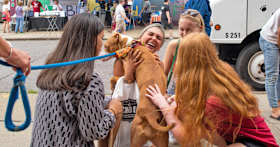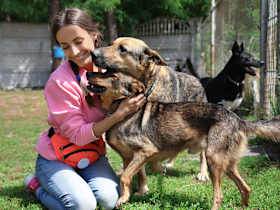What to Know About Pet Adoption Paperwork
Are you finalizing a new pet’s adoption? Learn everything you need to know about pet adoption paperwork.
Are you finalizing a new pet’s adoption? Learn everything you need to know about pet adoption paperwork.
by Kelly Villa, | March 19, 2025

Jimena Roquero / Stocksy
Adopting a pet is a rewarding experience — but the application paperwork? Not so much. While the adoption process for cats, dogs, or other pets may vary from one shelter or rescue organization to another, one thing remains consistent: It will involve filling out pet adoption paperwork. Here’s what you need to know before adopting a pet.
By understanding the various types of paperwork and preparing accordingly, you can streamline the adoption process and get your new family member home as soon as possible.
Pet adoption paperwork is a set of documents that you will need to complete when you adopt a pet from a shelter or rescue organization. The paperwork typically includes an adoption application, an adoption agreement, and veterinary records. In some cases, you may also need to provide additional paperwork, such as proof of residency or a landlord’s permission, if you are planning to rent with a pet. This paperwork is important for a number of reasons:
Pet adoption applications help ensure that you and your pet are a suitable match. One of the primary goals of pet adoption paperwork is to gather information about the adopter’s living situation, lifestyle, and preferences to make sure the pet’s needs align with their potential new family.
Pet adoption paperwork also often includes legal agreements that help protect everyone involved in the adoption. For example, this paperwork often includes agreements that cover topics such as pet care, medical care, and return policies. It might also outline the responsibilities of both the adopter and the shelter or rescue organization.
Adoption paperwork will give you information about the pet’s health. Their health records include vaccination history, proof of spaying/neutering, and any health issues they came in with. This ensures you are aware of your new pet’s health status and can effectively continue to care for them.
The length of adoption paperwork varies — some are shorter, while others are quite extensive. But there are three main types of pet adoption paperwork, including the following:
The adoption application is usually the first document you’ll complete. It asks questions about your living situation, experience with pets, and the type of pet you’re looking for. It’s essential to be honest and thorough in your responses, as this information helps the shelter or rescue organization determine the best match for you.
This legally binding document outlines the responsibilities and expectations for both the adopter and the shelter or rescue organization. It covers topics such as pet care, spaying/neutering requirements, and the process for returning the pet if necessary.
Many adoption agencies will ask for proof of residency, such as a utility bill or lease agreement. This is to ensure that you live in a pet-friendly apartment or home and can provide a suitable home for your new companion.
The first step you can take to prepare for completing your adoption paperwork is to do some research. Once you choose an organization from which you’d like to adopt, you can start gathering all of the documents and information you’ll need to complete the adoption paperwork. These documents might include proof of residency and any references a shelter or organization may want to contact.
Other information you should be prepared to provide:
Your contact information
Your veterinarian’s contact information
The ages of people who live in your home
The types and ages of other animals who currently live in your home
Information about past animals who have lived in your home
If you (or anyone in your home) have allergies
Information about your future pet’s living situation (such as where they’ll sleep and if you have a yard)
Your availability (to help gauge how long they’ll be alone)
Personal references to vouch for your readiness as a pet parent
They might also ask you about your knowledge and experiences as a pet parent:
Your understanding of socialization, especially if considering a young pet
What type of training methods you plan to use
Your tolerance level for common behavioral challenges
You can get pet adoption paperwork directly from the shelter or rescue organization you plan to adopt from. Most organizations make these documents available either in person, online, or by contacting their adoption coordinator.
No matter where you complete the paperwork, however, carefully read and make sure you understand each document before signing anything. If you have questions or concerns, don’t hesitate to ask someone at the shelter or rescue organization for clarification.
Adopting a pet is a big commitment but some pets can be adopted quickly, so it’s important to be proactive and promptly submit all required materials. Be sure to ask the shelter or rescue organization you’ve decided to adopt from about any specific deadlines for completing the paperwork. Typically, the adoption process moves forward once your application has been reviewed, but it may also require a home visit.
The adoption paperwork process may seem a bit intimidating at first, but following these steps can help make it as smooth as possible.
Be patient and understanding. The pet adoption process, including filling out paperwork and waiting for a shelter or rescue to process it, might be time-consuming. It’s essential to remember that the shelter or rescue staff are doing their best to ensure the well-being of the pets in their care. They want to find them the best homes possible, which can mean taking time to do their due diligence, ask questions, and gather information.
Ask questions if you’re not sure about something. It’s crucial to be honest and transparent during this process — both in the answers you provide and if you have any questions for the shelter or rescue staff. The people on the receiving end of your paperwork are there to help and can provide guidance.
Be prepared to provide additional information or documentation if needed. Shelters or rescue organizations might request additional information, including proof of address, a landlord’s approval, references, or veterinary records for any current pets. Be prepared to provide this information to demonstrate that you’re willing to go the extra mile to ensure your new pet’s well-being.
There are typically fees associated with pet adoption. The specific fees vary depending on factors such as the policies of the animal shelter or rescue you choose to adopt from, any medical treatments the animal underwent in their care (including vaccinations and spaying/neutering), any transportation costs, and more. Essentially, these fees help cover the costs accrued by the organization in caring for the animal and help them continue their life-saving work.
If you lose adoption paperwork, you can contact the animal shelter or rescue from which you adopted their pet; they usually keep records of adoptions and can provide you with copies of the necessary documents. It is essential to maintain these records, however, especially in case of emergencies, so consider making copies and storing them in a safe place.
A microchip is a small device that can be implanted in your pet and contains a unique identification number. It’s usually injected under the skin between your pet’s shoulder blades and is essential for both identification (it’s a permanent form of identification that greatly increases the chances of reuniting with your pet if they go missing) and proof of ownership. Many animal shelters and rescue organizations ensure the pets they adopt out are microchipped to offer peace of mind to everyone involved. Your pet adoption paperwork will include the microchip number of your pet.
Weiss, Emily, et al. “Do Policy-Based Adoptions Increase the Care a Pet Receives? An Exploration of a Shift to Conversation Based Adoptions at One Shelter.” Open Journal of Animal Sciences, vol. 04, no. 05, 2014, pp. 313–322, www.scirp.org/journal/PaperInformation.aspx?PaperID=50847, https://doi.org/10.4236/ojas.2014.45040.
“Tips on Telling Adoption Applicant Their Application Is Not Approved | Animal Welfare Professionals.” Maddiesfund.org, 2024, forum.maddiesfund.org/discussion/tips-on-telling-adoption-applicant-their-application-is-not-approved. Accessed 19 Mar. 2025.
“About Adoption.” Www.laanimalservices.com, www.laanimalservices.com/about-adoption.
“How Adoption Works.” Animal Humane Society, www.animalhumanesociety.org/resource/how-adoption-works.

Kelly Villa is a freelance writer and contributor to various pet publications.

Adoption Advice

Adoption Advice

Shelters & Rescue

Foster & Volunteer
Kitten season is coming! During the warmer months, kitten births skyrocket — and it has a dramatic effect on shelters.

Adoption Advice
Adopting a dog is a BIG decision. If you’re considering getting a new pup, consider a foster-to-adopt program to test the waters first.

Adoption Advice
Learn more about how you can find a dog shelter that meets your expectations.

Adoption Advice
Adopting a new puppy? We've created a checklist to help you get organized before bringing your new friend home.

Shelters & Rescue

Shelters & Rescue
Debunk a few animal shelter myths and learn the benefits of adopting from a shelter or rescue group.

Adoption Advice
Yes, there is a difference. Read on for everything you’ll ever need to know to distinguish one from the other.

Shelters & Rescue
Looking to adopt from a shelter? This guide will help you familiarize yourself with common shelter terminology about both the adoption process and pet profiles.

Adoption Advice
Bringing home a cat? Here’s what you’ll wish you knew sooner.